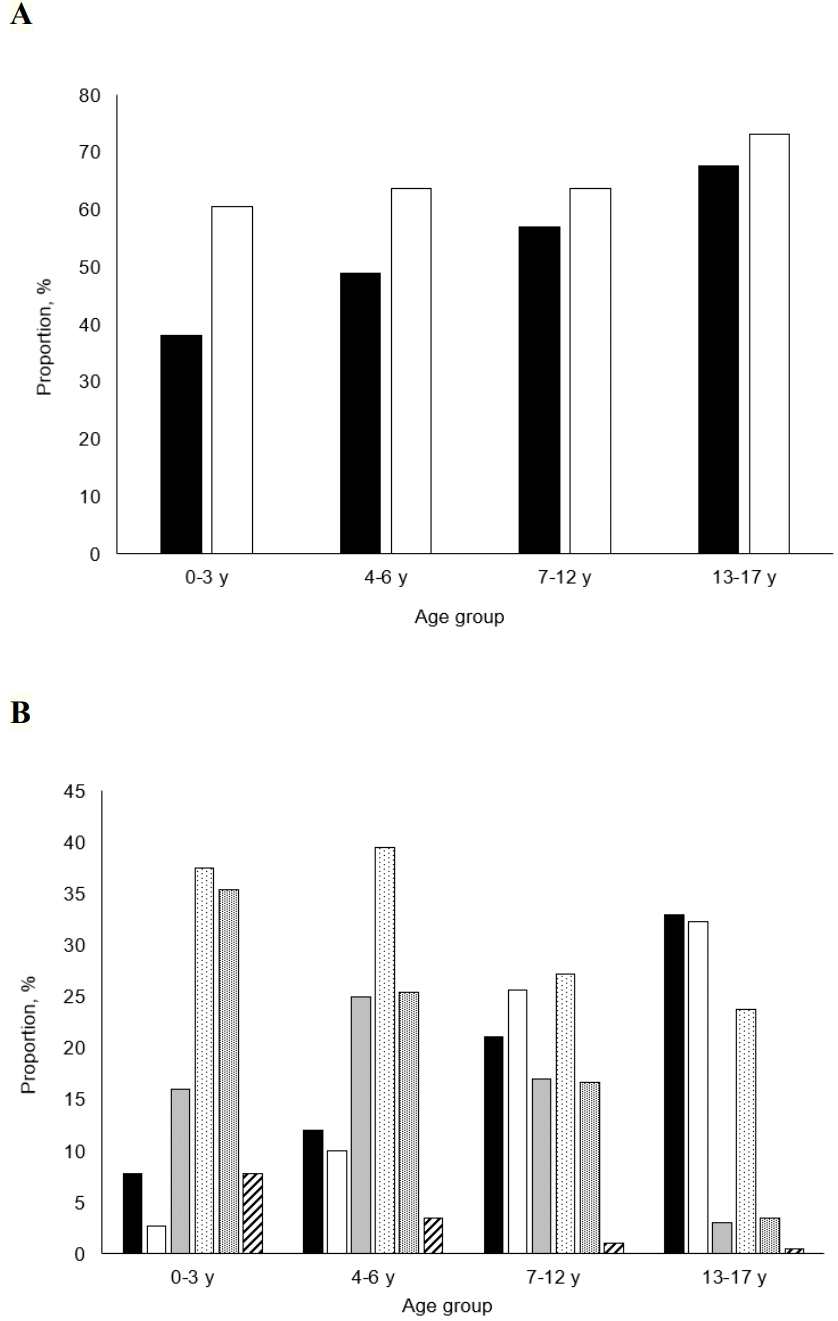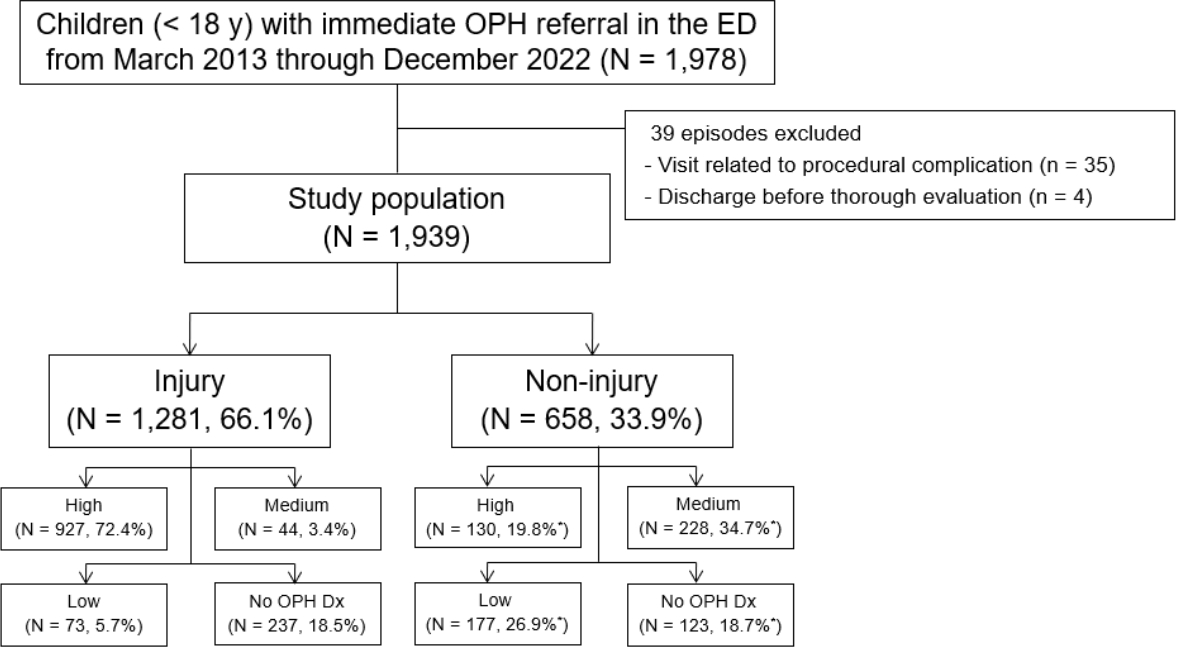Discussion
This study shows an association of high OPH severity with injury, older age, and boys. We discuss the dual implications for decision-making in children with eye-related symptoms who visit EDs. Children with high-to-medium severity probably have true OPH emergencies, which require emergency surgery, hospitalization, or expert opinion, compelling immediate referrals or transfers to ophthalmologists. Conversely, for children with low severity, emergency physicians or pediatricians may play some roles of on-call ophthalmologists in EDs, and divert the children to outpatient departments or outside clinics within a few days. The efficient use of emergency medicine resources is predicated on the non-ophthalmologists’ capability to make presumptive OPH diagnoses.
The study findings are consistent with those of a recent study performed in Wills Eye Hospital ED in terms of median age (9.8 years), the most common age group (15-18 years), injury mechanism (sports), and diagnosis (conjunctivitis) (
8). As per a 2006-2014 United States Nationwide Emergency Department Sample (NEDS)-based study, “strike to the eye (22.5%)” was the most common mechanism, followed by “sports (14.2%),” which differs from the current study where sports were the predominant mechanism (
13). This difference might stem from the higher proportion of injured children aged 10-17 years in our study (37.5% vs. 49.9% [639 of 1,281]) (
13). Two Korean ED-based studies on ocular injury performed on patients of all ages listed “hyphema, eyelid laceration, and orbital fracture” and “corneal abrasion, orbital contusion, and hyphema” as the top 3 diagnoses, respectively (
12,
14). These diagnoses contain the top 3 injuries of the current study. Consistent with our study, the 2 Korean studies (
12,
13) reported football and baseball as the 2 most commonly causative sports activities (
Appendix 3).
The association of injury with high OPH severity may be due to the following factors. First, trauma to the eye and its adnexa results in obvious wounds impacted by foreign bodies, or bleeding, which intuitively prompts emergency intervention. Second, OPH hospitalization is more frequent in injured children than in ill children (
8). Third, by definition, an injury diagnosis is more likely to be regarded as highly severe than a non-injury diagnosis. As per a 2006-2011 United States NEDS-based study, a chief reference for the OPH severity, all diagnoses related to laceration or foreign bodies are categorized as “likely to be emergent (
1).” In contrast, preseptal cellulitis, hordeolum, most conjunctivitis, and even optic neuritis are sorted as “nonemergent” or “could not be determined.” This categorization is in line with our rating of OPH severity (
Tables 1 and
2).
The association of boys with high OPH severity may be related to the fact that 74.6% of the children with injuries are boys, which is inherently associated with the high severity of injuries (
Table 5). Relevant studies show that boys account for 63%-68% of children with ocular injuries who visit EDs (
13,
15). The role of older age could be explained by the tendency for outside-the-home injuries in older children (
Appendix 4) and age-related increases in sports, assault, eye pain, visual loss/blur, diplopia, and other visual symptoms (
Appendix 9). For instance, if an adolescent with diplopia is diagnosed with benign oculomotor nerve palsy, he or she would be regarded as having a high OPH severity (
1). The higher proportion of boys, older age, and higher OPH severity in our study are consistent with the findings of a Korean single ED-based study comparing children with general trauma and those with diseases (
9).
In this study, 54.5%-68.5% of the children were considered candidates for OPH referrals. In EDs, in addition to high OPH severity, cases requiring only emergency OPH examinations (i.e., medium severity [14.0%]) can also be considered near emergencies. It is difficult to reduce such referrals. However, we found a minimal portion of potentially unnecessary referrals from children with low OPH severity or no OPH diagnosis (31.5%). The low-severity referrals can be decreased by enhancing emergency physicians’ or pediatricians’ knowledge and experience of OPH diseases and minor injuries. Depending on their clinical competence, the cutdown on unnecessary referrals may extend to some cases of medium OPH severity. The need for cutdown should be highlighted in infants or toddlers who require additional measures, such as procedural sedation and analgesia, for a detailed examination.
A discordance between KTAS 1-2 and OPH severity was observed, as exemplified by the fact that 3.6% of children with high severity were categorized as under KTAS 1-2 (
Appendix 8). The discordance was also shown between KTAS 1-3 and the severity. This feature is likely due to the consideration of KTAS outside the primary diagnosis (e.g., vital signs) and the localized features of eye-related symptoms. Thus, emergency physicians or pediatricians may need to prioritize referrals or interventions for children with the symptoms, regardless of the initial KTAS.
Some miscellaneous findings are notable from the emergency medicine perspective. First, although most cases of conjunctivitis are classified as medium-to-low OPH severity, herpes simplex infection should be distinguished by the presence of vesicles or corneal dendrites owing to its potential for developing blindness and contraindications for frequently prescribed steroids. Second, we found 2 children with thelaziasis, infection by
Thelazia callipaeda, of whom 1 underwent removal of the parasite (
Appendix 6). This eye-specific parasite warrants attention in EDs, given its potential for causing keratitis and anxiety-provoking features in children or guardians. Third, because ball sports are commonly related to injuries, such as an orbital fracture or hyphema via ball-to-eye collision, protective eyewear should be used in a compulsory way (
13,
14).
This study has limitations. First, there might be inherent bias related to the single-center design. However, the study population is larger than that of the relevant Korean multicenter study (n = 446) (
14). Second, given the lack of numerical data regarding visual acuity, we could not assess visual outcomes, irrespective of the diagnosis-based severity. Third, we could not determine the general conditions and diagnoses beyond the OPH scope because diagnoses made or procedures performed by ophthalmologists were the focus of data collection.
Briefly, true OPH emergencies may be more prevalent among injured, older, or male children. The study findings could help emergency physicians and pediatricians in directing their attention toward children exhibiting signs of true emergencies, thereby redirecting less urgent cases to outpatient departments or outside ophthalmology clinics.
Go to :






 PDF
PDF Citation
Citation Print
Print




 XML Download
XML Download